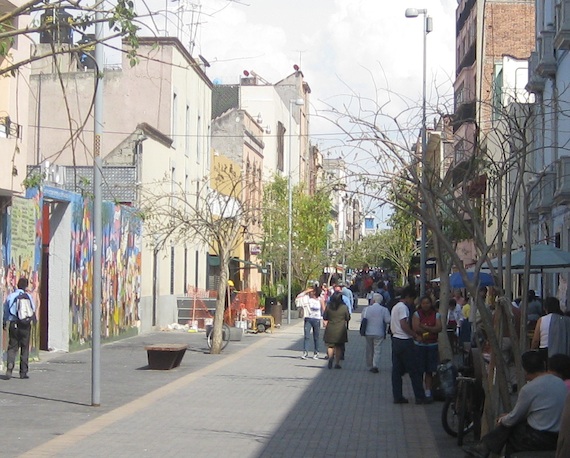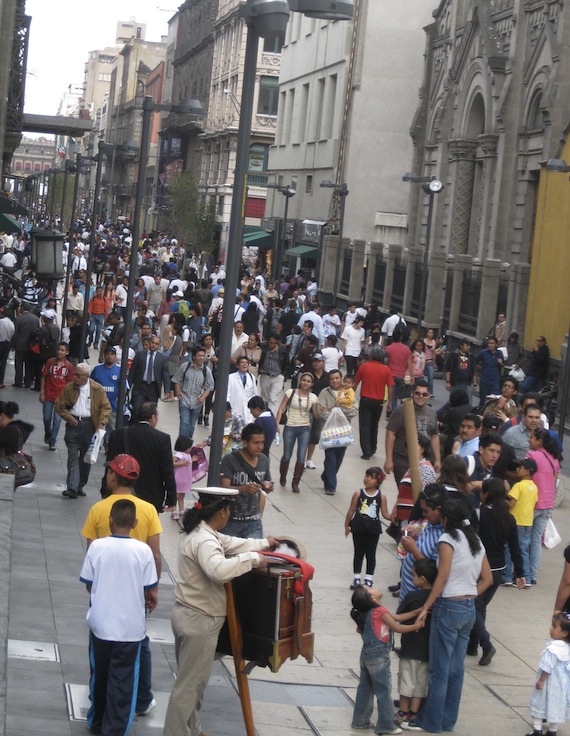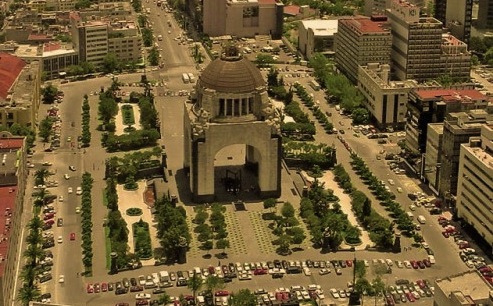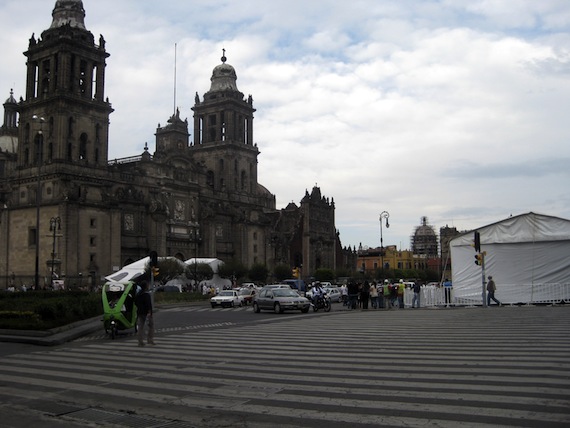
This is the first in a series of reports about sustainable transportation policies in Mexico City. Last week, Streetsblog participated in a tour of the city led by the Institute for Transportation and Development Policy and funded by the Rockefeller Foundation. Upcoming installments will cover the city's transit expansions, particularly its new bus rapid transit lines, and its bicycle planning.
Reclaiming Mexico City's Calle Regina for pedestrians proved more difficult than simply closing the historical street to traffic. If anything, drivers had more trouble passing through the area than those on foot.
"All the space was taken by vendors," said Walter Hook, the CEO of the Institute for Transportation and Development Policy. "It was a little bit like a war when they got rid of them." As the administration of Mayor Marcelo Ebrard, a former police chief, cleared the area, authorities found caches of drugs and guns, said Hook. Different colored tarps announced which gangs protected each vendor. Only after removing the vendors could officials turn their attention to making Calle Regina car free.
On the Calle Francisco I. Madero, the challenge to pedestrianization was more traditional: the opposition of small businesses along the narrow street. Madero is "the most symbolic connection, maybe, in the country," said Daniel Escotto, head of Mexico City's Public Space Authority. On one end of the street is the Zócalo, the central square that has been the spiritual heart of the country from when it hosted the chief temple of Tenochtitlan through Spanish colonization to the political turmoil of today. On the other end is the city's single busiest intersection, its fine arts museum, and its oldest park.
Despite enormous pedestrian volumes, Madero's business owners, largely local shopkeepers, resisted all efforts to take away motor vehicle access, said Escotto. "Let me just have one day, with cones," Escotto recalled asking the local chamber of commerce.

On both streets, the results have been impressive. On Madero, Escotto started by blocking traffic on Mondays, working with merchants to measure the effect of temporary pedestrianization. After just two weeks, the program was extended to include Tuesdays. "In three months, we got it completely closed," he said. The city is confident enough of the improvement that it repaved the street, eliminating curbs that formerly demarcated space for people and cars.
Differently colored pavers still stand as a testament to the former limits of the sidewalks. It's impossible to imagine the current crowds -- 200,000 people per hour according to Escotto -- restricted to those narrow bands. Even the most ferociously opposed merchants have changed their tune with that many potential customers passing by, said Escotto.
On Regina, as in much of Mexico City's old downtown, disinvestment had taken such a toll that one of the road's historic buildings completely collapsed during the city's 1985 earthquake. Rather than redevelop the site, it was converted into a parking lot. After the street was pedestrianized, however, the lot was turned into a playground and is now usually filled with children. Around it are busy shops and cafés. Many of the surrounding buildings are owned by Carlos Slim, the world's richest man, and it is believed that the changes to Regina have made Slim's holdings worth that much more.

Perhaps even more symbolic than the pedestrianization of Francisco I. Madero are the changes Mexico City has made to the Plaza de la República. A grand square, the site was originally meant to host a new Beaux Arts building for the country's legislature. Only the steel skeleton for the structure's dome was completed, however. After the Mexican Revolution, the steel was wrapped with an Art Deco skin and converted into a monument. Each leg of the open dome serves as a mausoleum for one of the revolution's leaders.

Successive governments turned the streets around the monument, and even the edges of the plaza itself, over to motor vehicles. "Most of the spaces in the last thirty or forty years were made for cars," Escotto explained. Wide roads and surface parking defined the space.

In honor of the revolution's bicentennial, the city transformed the space. Sidewalks were widened and beautified with new street furniture and plantings. Plaza space once given over to car parking was reclaimed, creating room for amenities like a new fountain, which on my visit was filled with children enjoying a chance to cool off. Simultaneously, the city installed an elevator to the top of the monument, creating a new draw for visitors.

Though significant, none of these downtown pedestrianization efforts can compare with the symbolic importance of what the Ebrard administration has planned next: taking traffic off the Zócalo entirely. The enormous square offers plenty of open space, but is ringed by up to four lanes of traffic. The roadway divides the plaza itself from the Metropolitan Cathedral, home to the Archdiocese of Mexico, and the National Palace, the former seat of viceroys, emperors and presidents. It's the kind of space where any pedestrianization project should be designed with an eye toward visits from dignitaries.
Escotto wants to turn the entire Zócalo over to pedestrians this year.





